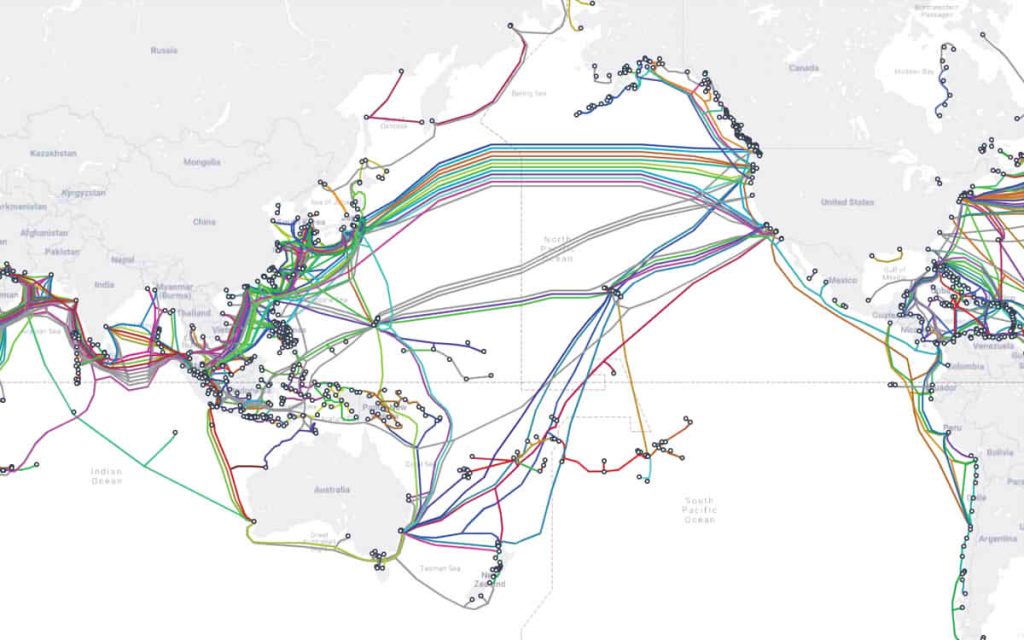In a historic milestone for digital connectivity, the United States Trade and Development Agency (USTDA) announced during the Asia-Pacific Economic Cooperation business summit (APEC) in San Francisco that a grant for a feasibility study will be awarded to the Malaysian consulting firm Hexa Capital Consultancy. The objective of this study is the development of the first direct MYUS submarine cable system that will connect Malaysia and the United States, marking a new era in transpacific digital collaboration.

Table of Contents
- The MYUS Project and its Essential Details
- The Expected Impact of the MYUS Cable
- Background: Important Transpacific Cables
- A Connected Future
The MYUS Project and its Essential Details
Malaysia, a country that is already connected through 18 systems of international cables, takes a step forward with the MYUS submarine cable project. Despite having several connections, like the Asia-America Gateway (AAG) Club Cable, that links with the United States, MYUS is positioned as a significant advance by establishing the first direct submarine cable between these two nations.
The MYUS cable is expected to have an impressive extension of more than 19,220 kilometres, with plans to include six landing stations in Southeast Asia, covering countries like Indonesia, Malaysia and the Philippines. Besides, three landing stations will be established in different states and territories of the United States on the Pacific side. Although detailed information on the planned capacity of the MYUS cable has not yet been provided, This initiative is expected to provide a significant improvement in transpacific connectivity.
To carry out detailed project research and planning, Hexa Capital Consultancy has selected TSoja & Associates, a company with experience in the design and implementation of large-scale digital infrastructure projects.

The Expected Impact of the MYUS Cable
It's a statement, the Director of USTDA, Enoh T. Ebong, highlighted the strategic importance of fiber optic cable for communication MYUS by stating that “will cost-effectively improve digital connectivity and increase opportunities for reliable and affordable digital services across the Southeast Asia region, including remote and underserved areas, by establishing secure communication links between Southeast Asian countries and the United States”.
This suggests that the MYUS cable will serve as a means of improving communications speed and reliability.. And it will also act as a catalyst for economic growth in the Southeast Asian region, by opening up new business opportunities and cross-border collaboration.
The CEO of Hexa Capital, The doctor. Brother Azhari Hadari, complemented this vision by highlighting that the MYUS cable will contribute to the “support of the deployment of 5G wireless services and increased investment in data centers”. Advanced digital infrastructure provided by cable will improve everyday connectivity. It will also lay the foundation for the adoption and expansion of emerging technologies.
Background: Important Transpacific Cables
To fully understand the impact of the MYUS project, It is essential to contextualize it within the historical framework of the transpacific submarine cables. From the first transpacific submarine cable system, TPC-1 (Trans Pacific Cable 1), which entered service in 1964, to the most recent connections, These cables have been crucial in facilitating international communication.

Unity
The Unity transpacific submarine cable system is a key example of international collaboration in this area. Connect Grow, Japan, with Los Angeles, USA, throughout 9620 km and entered service on 1 April 2010. Owned by a consortium including Bharti Airtel, Global Transit, Google, KDDI Corp., Pacnet (now Telstra) y SingTel, Unity has been a strategic investment with a design capability of 7.68 Tbps.
TPE
The submarine cable system Trans-Pacific Express (TPE) is another outstanding example. Completed in September 2008, directly connects China and the United States. The consortium includes China Unicom, China Telecom, Verizon Business, Korea Telecom, Chunghwa Telecom, NTT y AT&T. With a design capacity of 5.12 Tbps, TPE has significantly improved connectivity between these two powers.
SEA-US
The SEA-US submarine cable system has been instrumental in ensuring stable connectivity in earthquake-prone areas in East Asia. With a length of approximately 15,000 kilometers and a design capacity of 20 Tbps, SEA-US has been in service since August 2017, connecting areas from Manado in Indonesia to Los Angeles, California.
JUPITER
JUPITER submarine cable system connects Maruyama and Shima in Japan with Los Angeles, California, and Diet in the Philippines. With a length of 14,600 km and a design capacity of more than 60 Tbps, JUPITER has improved the diversity of transpacific connections. The consortium includes Amazon, Facebook, NTT, PCCW Global, PLDT y SoftBank.
A Connected Future
With the announcement of the MYUS cable, The United States and Malaysia usher in a new era in digital connectivity. This project not only improves the speed and reliability of transpacific communications, but also unleashes economic opportunities in Southeast Asia, promoting the adoption of advanced technologies and data center expansion.
The MYUS cable submarine fibers not only represents a technical achievement, but a catalyst for international collaboration. By connecting continents, not only facilitates efficient data transmissions, but also opens the door to a more advanced and collaborative digital era.
In this project, Underwater technology becomes a vital artery connecting nations, promoting the convergence of cultures, economies and knowledge. The strength of transpacific connectivity promises a seamless exchange of information and a connected, prosperous future for all involved.
The MYUS cable emerges as a beacon on the technological horizon, lighting the way to a tomorrow where global collaboration, innovation and prosperity intertwine. On this journey towards a connected future, MYUS stands as a fundamental pillar, forging ties that transcend borders and anticipating a more cohesive digital world full of possibilities.

